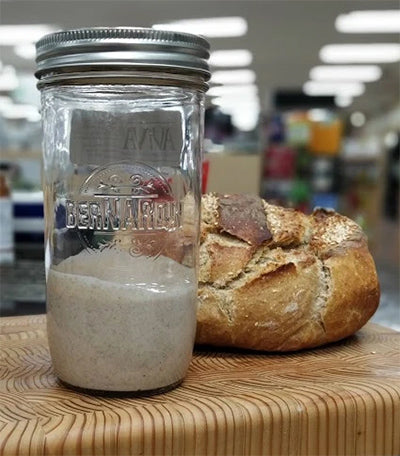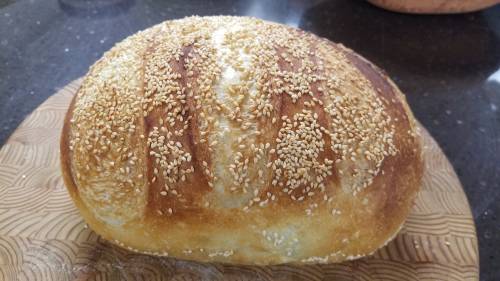Bake Healthier Bread Using a Sourdough Starter
An overarching aspect of my life has been my passion for cooking, baking, and sharing healthful, creative, delicious food. In recent years I've continued to research and experiment with healthier methods of food preparation including steaming and sous vide, but due to the proliferation of fine sourdough bakeries in Winnipeg, I stopped baking bread which I did frequently years ago.

When my favourite bakery (The Pennyloaf Bakery) temporarily closed due to COVID-19, I decided to start baking again. While most bakers use yeast, there are many healthful benefits to using sourdough as a leavening agent. Sourdough starter is created through the fermentation of flour and water using "wild yeasts" that naturally occur on grain.
I had never baked with a sourdough starter before, and like many, I found the process a bit intimidating at first. But thanks to YouTube and some excellent books, I have a sourdough starter that makes excellent bread. For those that don't have the time to create and maintain a sourdough starter, I recommend O-tentic, a dehydrated sourdough from Belgium you add to flour (like yeast) that produces incredible sourdough bread.
As it takes longer to ferment, sourdough bread is more flavourful thanks to the production of organic acids (including acetic and lactic acid), which lower the pH of bread while neutralizing phytates that can inhibit the absorption of minerals. Lactic acid boosts the bioavailability of naturally-occurring minerals including calcium and magnesium.

The yeast and bacteria produced during the fermentation of the sourdough starter help break down gluten. This makes bread more digestible, especially for those who are gluten sensitive. Many people that experience bloating from the gluten in regular bread find they can eat sourdough without any digestive issues. While better for those with gluten sensitivities, gliadin (the protein in wheat that affects those with celiac disease), remains present. For those with celiac disease, you can make a sourdough starter from chickpea flour that produces sourdough gluten-free breads that are similar to traditional breads in volume and taste. Sourdough is also a natural "prebiotic" which acts as food for the beneficial bacteria in the gut, helping to improve the health of the gut microbiome.

Mixing vs No-Knead Methods
Before I learned about the "no-knead" method I used an electric mixer to make bread dough, adding all the ingredients and letting the mixer do all the kneading. For many years I used the Bosch Universal Mixer, as many of the popular kitchen mixers are not strong enough to knead dough made of 100% whole wheat flour. Standard mixers work fine if you add some white flour to lighten the load on the motor, and they're great for cookie dough, whipping creams, egg whites, meringues, and making pies and cakes. But you will quickly burn out the motor on a KitchenAid or similar mixer with 100% whole grain bread dough. The design of the Bosch handled the heaviest of bread doughs, developing the gluten without straining the motor. The Swedish Ankarsrum Original is even more powerful and is the world's best and most versatile kitchen machine.
Easier than using a mixer, the no-knead method is revolutionary as it eliminates the kneading requirement and produces amazing breads that are healthier than those produced using conventional methods. The no-knead method uses a long fermentation (overnight or longer), a very wet dough (75% or higher hydration), and very little yeast (or sourdough starter) to form gluten strands that give bread flavour and texture. No-knead bread takes only minutes a day and produces the most delicious, moist, flavourful bread.
Grinding Grain
When you buy white or whole wheat flour that is ground, the germ of the grain is removed to prevent rancidity. Rich in wheat germ oil and healthy fats, the germ is the most nutritious part of the grain. Additionally, ground flour loses 40% of its vitamin content after only 24 hours (B-vitamins, enzymes, vitamins A and E), with 85-90% lost after only 2-3 days. I recommend purchasing organic whole grains and a grain grinder. Grinding the grain just before making your bread dough maximizes the nutritional content. I recommend grain grinders from WonderMill (an impact-micronizing grinder) and KoMo models that use stone burrs.
You can make incredible and nutritious bread using freshly ground grain, purified water (chlorine and fluoride-free), sourdough starter (or O-tentic), and salt. I love baking delicious, flavourful sourdough bread and sharing it with friends.
Health Disclaimer. Copyright ©2020. Nathan Zassman is a trained nutrition practitioner and the owner of Aviva Natural Health Solutions.
